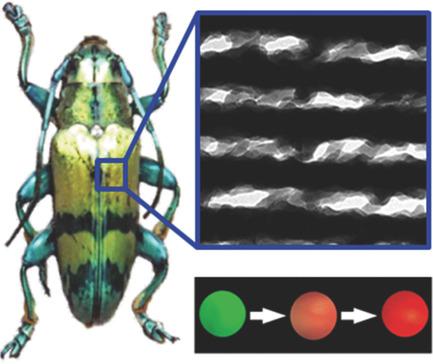当前位置:
X-MOL 学术
›
Adv. Funct. Mater.
›
论文详情
Our official English website, www.x-mol.net, welcomes your feedback! (Note: you will need to create a separate account there.)
Laser Interference Lithography for the Nanofabrication of Stimuli‐Responsive Bragg Stacks
Advanced Functional Materials ( IF 19.0 ) Pub Date : 2017-09-13 , DOI: 10.1002/adfm.201702715 Nan Jiang 1, 2, 3 , Haider Butt 4 , Yunuen Montelongo 5, 6 , Feng Liu 7 , Samson Afewerki 1, 2 , Guo‐Liang Ying 1, 2, 8 , Qing Dai 9 , Seok‐Hyun Yun 2, 10 , Ali K. Yetisen 2, 10
Advanced Functional Materials ( IF 19.0 ) Pub Date : 2017-09-13 , DOI: 10.1002/adfm.201702715 Nan Jiang 1, 2, 3 , Haider Butt 4 , Yunuen Montelongo 5, 6 , Feng Liu 7 , Samson Afewerki 1, 2 , Guo‐Liang Ying 1, 2, 8 , Qing Dai 9 , Seok‐Hyun Yun 2, 10 , Ali K. Yetisen 2, 10
Affiliation

|
Dynamic structural coloration in Tmesisternus isabellae beetle elytra is a unique example of Bragg stack‐based wavelength tuning in response to external stimuli. The underlying principles could guide the design of quantitative optical stimuli‐responsive polymers. Existing nanofabrication techniques to create such materials are costly, time‐consuming, and require high expertise. This study reports a nanofabrication method to produce slanted Bragg stack structures in poly(acrylamide‐co‐poly(ethylene glycol) diacrylate) hydrogel films by combining laser interference lithography and silver halide chemistry in a cost‐effective and rapid process (≈10 min). The Bragg stacks consist of silver bromide nanocrystal multilayers having a lattice spacing of ≈200 nm. Upon broadband light illumination, the Bragg stacks diffract a narrow‐band peak at 520 nm at ≈10° with respect to the normal incidence. The lattice spacing of the hydrogel films can be modulated by external stimuli to shift the Bragg peak for dynamic quantitative measurements. To demonstrate the utility of this method, the Bragg stacks are functionalized with phenylboronic acid molecules. Bragg peak shift analysis allows reversible glucose sensing within a physiological dynamic range (0.0–20.0 mmol L−1) having a sensitivity of 0.2 mmol L−1. The developed Bragg stacks may have application in portable, wearable, and implantable real‐time medical diagnostics at point‐of‐care settings.
中文翻译:

激光干涉光刻技术用于纳米响应刺激布拉格堆叠的制备
Tmesisternus isabellae甲虫鞘翅中的动态结构着色是响应外部刺激基于布拉格堆栈的波长调整的独特示例。基本原理可以指导定量光学刺激响应性聚合物的设计。现有的制造此类材料的纳米加工技术成本高昂,耗时且需要很高的专业知识。这项研究报告了一种纳米制造方法,该方法可在聚丙烯酰胺共聚物中产生倾斜的布拉格堆叠结构。通过在经济高效且快速的过程中(约10分钟)结合激光干涉光刻技术和卤化银化学方法制备聚(乙二醇)二丙烯酸酯)水凝胶薄膜。布拉格堆叠由晶格间距约为200 nm的溴化银纳米晶体多层组成。在宽带光照射下,布拉格堆叠相对于法向入射在520 nm处约10°处的窄带峰发生衍射。水凝胶薄膜的晶格间距可以通过外部刺激来调节,以移动布拉格峰,从而进行动态定量测量。为了证明该方法的实用性,将布拉格堆叠物用苯基硼酸分子官能化。Bragg峰位移分析允许在生理动态范围(0.0–20.0 mmol L -1)中进行可逆的葡萄糖传感,灵敏度为0.2 mmol L-1。所开发的布拉格堆栈可能会应用于即时医疗设置中的便携式,可穿戴和可植入实时医疗诊断中。
更新日期:2017-09-13
中文翻译:

激光干涉光刻技术用于纳米响应刺激布拉格堆叠的制备
Tmesisternus isabellae甲虫鞘翅中的动态结构着色是响应外部刺激基于布拉格堆栈的波长调整的独特示例。基本原理可以指导定量光学刺激响应性聚合物的设计。现有的制造此类材料的纳米加工技术成本高昂,耗时且需要很高的专业知识。这项研究报告了一种纳米制造方法,该方法可在聚丙烯酰胺共聚物中产生倾斜的布拉格堆叠结构。通过在经济高效且快速的过程中(约10分钟)结合激光干涉光刻技术和卤化银化学方法制备聚(乙二醇)二丙烯酸酯)水凝胶薄膜。布拉格堆叠由晶格间距约为200 nm的溴化银纳米晶体多层组成。在宽带光照射下,布拉格堆叠相对于法向入射在520 nm处约10°处的窄带峰发生衍射。水凝胶薄膜的晶格间距可以通过外部刺激来调节,以移动布拉格峰,从而进行动态定量测量。为了证明该方法的实用性,将布拉格堆叠物用苯基硼酸分子官能化。Bragg峰位移分析允许在生理动态范围(0.0–20.0 mmol L -1)中进行可逆的葡萄糖传感,灵敏度为0.2 mmol L-1。所开发的布拉格堆栈可能会应用于即时医疗设置中的便携式,可穿戴和可植入实时医疗诊断中。



























 京公网安备 11010802027423号
京公网安备 11010802027423号